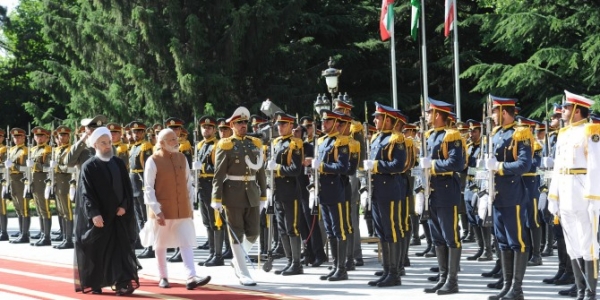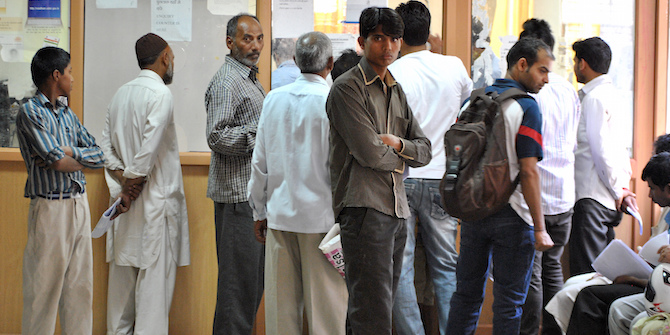Up until now India has been largely successful in balancing Iran, Saudi Arabia and Israel. In recent years economic collaboration has increased significantly, as all three powers have recognised the advantages of engaging with the growing Indian market. Although this offers India a great opportunity to make inroads into the region, Kabir Taneja notes significant domestic institutional reform will be needed if New Delhi is to compete with China in the region.
Little do most Indian citizens realise that West Asia (or the Middle East) has historically been one of the foremost foreign policy challenges for New Delhi. From Nehru’s outreach towards the region under the guise of the Non-Aligned Movement to supporting Saddam Hussein’s Ba’athist Iraq in the hope of protecting oil interests and secularism, India’s stake in the region has remained high on the back of political, economic and demographic challenges.
Prime Minister Narendra Modi has approached West Asia as an important part of India’s foreign policy. However, whether this outreach is backed by a critical sense of purpose is yet to be seen. Modi, over the past years, has visited Saudi Arabia, Iran and most recently Israel, becoming the first Indian Prime Minister ever to do so since diplomatic relations were set up with Tel Aviv in 1992 (the capital of Israel has been shifted to Jerusalem since).
India’s interests in and policies towards West Asia have historically been linear, despite the nature of government in power. Demographics have been a critical aspect of its policies towards the region, as more than 8 million Indians work and live in the larger West Asia region. The security of these people is of prime concern to New Delhi, and their well-being and success in the region are worth nearly $50 billion in remittances for the Indian economy per annum. To attain this, and beyond, New Delhi has played different roles at different times to maintain its postures in the region, that of protecting interests while maintaining its Nehruvian bent of non-alignment and anti-interventionism.
However, it is only now in the 2000s that India has enough leverage to make a strong case for partnerships with the West Asian powers. India has largely balanced its approach to the three poles of influence in the region – Saudi Arabia, Israel, and Iran – in a successful manner so that none of them has overtly criticised New Delhi for dealing with the others. The reasons behind this new-found zest – increased counter-terrorism cooperation between Riyadh and Abu Dhabi, joint-partnership in oil and gas with Tehran, and defence development with Israel – are mostly economic. The fact that India is one of the world’s fastest growing economies has given it leverage against the likes of Saudi Arabia, which was more than often cold and ignorant towards India’s voice against terrorism, especially on Pakistan, throughout the 1990s.

Today, all players in the three poles of power recognise that for their own success, regional agendas, and inter-regional rivalries, the Indian market as part of the Asian growth story will be critical. For example, both Iran and Saudi know that for oil and gas, it is not the West but countries like India, China, Japan, and South Korea that will remain the premier markets for the next two decades at least. Riyadh is now looking to follow in the UAE’s footsteps to develop an economy beyond oil and is looking towards Asia not just for hydrocarbon exports but investments via its sovereign funds as well (new developments such as India’s first imports of oil from the US could push both states to develop further ties more aggressively).
Meanwhile, in Iran, India is looking not just to invest in its large natural gas fields, but also develop the Chabahar port, which is expected to be a bridge of trade between India, Iran and central Asia along with Afghanistan, while also envisaged as a counter to the China-owned Gwadar port in Pakistan. While on the third front, Israel today stands with New Delhi quite emphatically, looking to bolster ties with the government of Modi and his party, the Hindu nationalist BJP. Modi’s trip to Tel Aviv and Jerusalem was a branded event, with Israel leaving no stone unturned in theatrics, press and red carpet treatment for the Indians. This is of course backed by the fact that Israel, unlike India’s other partners in defence procurement and development, has much more liberal norms on critical issues such as transfer-of-technology.
While these overtures from West Asia are perhaps circumstantial for them, for New Delhi this offers a rare opportunity to use its historically respected balance to make deep inroads in the region, specifically in the fields of energy security, and to push India’s anti-terrorism narrative. However, despite the reversal of interests between India and West Asia, New Delhi still has limited capacity to play large-scale diplomacy on foreign lands, specifically with an aggressive China looking to fill up vacuums left behind by receding Western power interests. India has its work cut out as well, as while Beijing has moved swiftly, backed by political and economic capacity to make a space for itself in the region – large investments across the board, and its first permanent international military base in Djibouti, just off the coast of Yemen – New Delhi has dragged its feet.
Tehran and New Delhi have been in a tussle over the Farzad B gas field, where India is expected to invest over $3 billion, as Iran balked on pricing while India struggled to move its financial commitments towards the same. This tussle between India and Iran is not an isolated incident, as successive governments have delayed projects largely due to financial strains, and the former’s constant highlighting of civilisational ties between the two nations being the bedrock of the relationship is nothing more than empty platitudes for Tehran which, arguably, sees the global order in realist terms much more than India.
Even as Modi’s international outreach has been persistent, selling the India story to a largely floundering global economic structure in its current form will result in few long-term changes. Structural changes are first made at home, with rigid domestic bureaucratic systems still standing in the way of the economy the prime minister envisions, which in turn is driving his outreach to global politics. While on the correct track, domestic institutional reform will lead India to develop into a strong Asian protagonist, a successful counter to China, and a political and economic heavyweight. To realise this aim and set course, West Asia offers a good opportunity today for India to work on. However, delays in realising this may find New Delhi staring as the door shuts on one of its greatest opportunities.
The LSE India Summit 2016 featured a panel on India and West Asia. Catch up with the discussions and read the recommendations here.
This article originally appeared on IAPS dialogue. It gives the views of the author, and not the position of the South Asia @ LSE blog, nor of the London School of Economics. Please read our comments policy before posting.
About the Author
Kabir Taneja is an Associate Fellow at the Observer Research Foundation in New Delhi. He tweets at @KabirTaneja.







